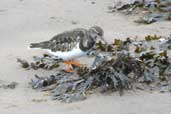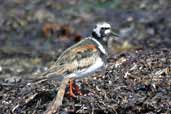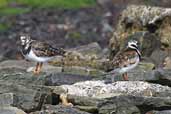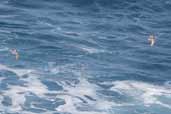|
Ruddy Turnstone (Arenaria interpres)
|
 |
Scotland
The Ruddy Turnstone breeds around the fringes of the Arctic in northern Europe, Asia, North America and Greenland. Birds from
north-east Canada and Greenland migrate to western Europe including the British Isles, birds from Scandinavia winter in Morocco and West Africa while
birds from central Siberia winter in the eastern Mediterranean and the Middle East.
|
 |
They nest close to the coast in fairly flat rocky or shingle areas. In winter they are entirely coastal and tend
to be seen on rocky shores, near seaweed or around harbours and sea-walls.
The name derives from its method of looking for its food of insects and shellfish which it finds by turning over stones,
shells, seaweed, etc., using its bill.
|
 |
It is readily identified from its sharp, wedge-shaped bill, its orange legs and its pied wing pattern in flight.
In summer, as seen in photos 2 and 3, it has bright orange-brown on the wing-coverts and scapulars while the head pattern is black and white. The
female (on the left in the 3rd photo) is duller with a less well-defined head pattern. In winter, as in photo 1, it loses the orange-brown on the
wings while it retains the bold, black chest band with a pale patch on either side of the breast. Underparts are white throughout the
year. |
 |
|
|
|



